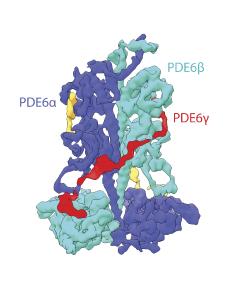
IMAGE: The structure of PDE6αβ2γ complex displaying PDE6α (purple), PDE6β (green cyan), and two molecules of PDE6γ (red and yellow) subunits. view more
Credit: UCI School of Medicine
In a study published in Science Advances magazine, researchers from the University of California, Irvine have captured, for the first time, the full-length structure of the rod photoreceptor phosphodiesterase 6 (PDE6), an enzyme that plays an indispensable role in human vision.
PDEs are associated with various diseases and are targets of several widely used drugs and major targets for drug development. Unfortunately, many of these enzymes have similar structures, particularly their catalytic domains, where the chemical reaction takes place. Because of this, inhibitors that target one type of PDE can stop the reaction in multiple members of the PDE family, resulting in unwanted side effects.
PDE5 inhibitors, for example, such as sildenafil (Viagra) and vardenafil (Levitra), which are used to treat erectile dysfunction and pulmonary hypertension, can stop the reaction in PDE6 resulting in side effects affecting vision.
“PDE5 inhibitors are associated with several visual side effects, including blurred vision, changes in color vision, extreme sensitivity to light, and in extreme cases, damage to the optic nerve that relays optical signals to the brain,” said Sahil Gulati, PhD. “These side effects are caused by the binding of PDE5 inhibitors to PDE6 in the retina.”
Several cases of patients experiencing vision changes after using sildenafil citrate have been reported.
Led by Gulati, researchers, including world renowned vision researcher Krzysztof Palczewski, PhD, director of the UCI Center for Translational Vision Research at the Gavin Herbert Eye Institute, Department of Ophthalmology at the UCI School of Medicine, and a team from the University of Basel in Switzerland, used single-particle cryo-electron microscopy to visualize the full-length PDE6 enzyme. They revealed fish-hook-like regions of the PDE6 structure that forms potential signal transduction routes from the regulatory domains of PDE6 to its catalytic domain.
“The high-resolution images we were able to capture clearly underscore the immense hidden beauty of human vision and reveal several features of PDE6 that were previously unseen,” said Gulati. “Included among them were some very promising regions of PDE6 that resemble fish-hooks. These regions are responsible for controlling PDE activity. By targeting the fish-hook-like region with a new class of PDE inhibitors, drug development companies may be able to eliminate unwanted side effects of certain PDE targeting drugs.”
###
Funding for this research was supported in part by grants from the National Institutes of Health (R24EY024864 and R01EY027283), Research to Prevent Blindness (RPB) and the Canadian Institute for Advanced Research (CIFAR).
About the UCI School of Medicine: Each year, the UCI School of Medicine educates more than 400 medical students, as well as 200 doctoral and master’s students. More than 600 residents and fellows are trained at UC Irvine Medical Center and affiliated institutions. The UCI School of Medicine offers an MD degree, a dual MD/PhD medical scientist training program, PhDs and master’s degrees in anatomy and neurobiology, biomedical sciences, genetic counseling, epidemiology, environmental health sciences, pathology, pharmacology, physiology and biophysics, and translational sciences. Medical students also may pursue an MD/MBA program, a combined MD/Master’s in Public Health or a dual MD/master’s program called the Program in Medical Education for the Latino Community (PRIME-LC). UCI School of Medicine is accredited by Liaison Committee on Medical Accreditation (LCME), and ranks among the top 50 nationwide for research. For more information, visit: som.uci.edu.
About the University of California, Irvine: Founded in 1965, UCI is the youngest member of the prestigious Association of American Universities. The campus has produced three Nobel laureates and is known for its academic achievement, premier research, innovation and anteater mascot. Led by Chancellor Howard Gillman, UCI has more than 36,000 students and offers 222 degree programs. It’s located in one of the world’s safest and most economically vibrant communities and is Orange County’s second-largest employer, contributing $5 billion annually to the local economy. For more on UCI, visit //www.
Disclaimer: AAAS and EurekAlert! are not responsible for the accuracy of news releases posted to EurekAlert! by contributing institutions or for the use of any information through the EurekAlert system.

